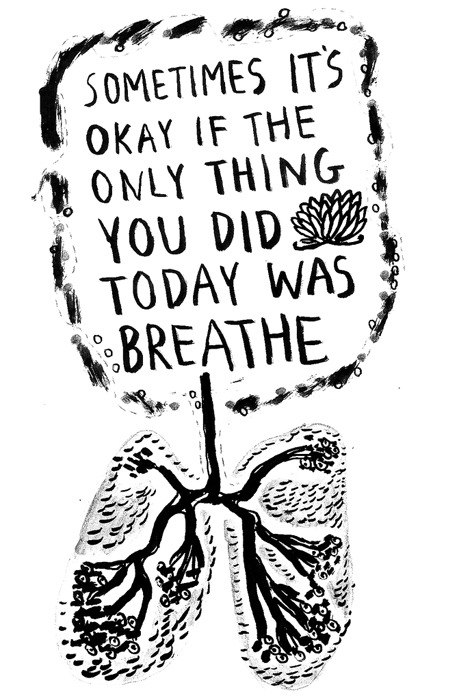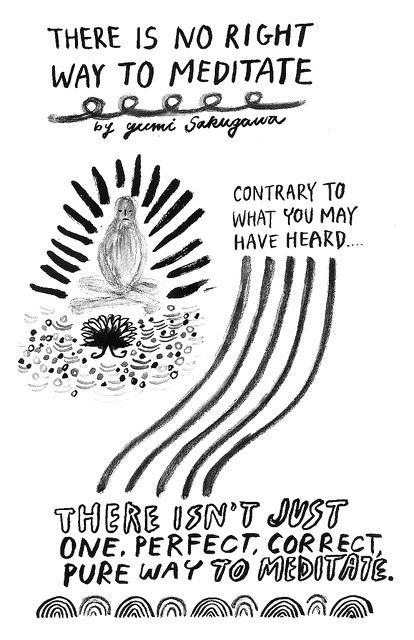
In Conversation
-
NameYumi Sakugawa
-
CraftIllustrator
-
LocationLos Angeles
-
What inspired your meditation guides and the mindful message behind your work?
It all started back in 2008 when I was fresh out of art school and working in Japan. Having just graduated, I had no idea what to do with my life and suddenly found myself abroad with no support system — I didn’t have access to therapy, medication, or my usual network of friends so I found myself tumbling into a deep depression. Serendipitously, A New Earth by Eckhart Tolle and David Lynch’s book, Catching The Big Fish were recommended to me, and I was introduced to the idea that you are not your thoughts but instead the silence between them. Having spent my whole life in a constant spiral of low self-esteem and a self-deprecating mindset this concept gave me a huge sense of relief because I didn’t have to identify with those thoughts anymore. This led me to throw myself into a regular meditation practice, which was like a rope that I could hold onto, leading me out of the lowest point in my mental health.
Naturally, because I’ve always drawn a lot, I started sketching about my experience in meditation. As somebody who’s always loved self-help books, I was surprised that there weren’t more visual representations of what meditation is because it’s such an abstract concept that it can be intimidating for some people. Sharing what meditation meant to me, in a way that didn’t seem intellectual or too conceptual, started as a fun side-project but organically took on a life of its own.
-
What rituals do you practice regularly? How do you overcome creative roadblocks?
I have a morning ritual that I do every day without fail. First, I fill a bowl of water as an offering to the genius and then I burn a tiny leaf of sage as an offering to the spirit. I started doing this after taking this witchy online course with Carolyn Elliot designed to help you get in touch with your magical side. I put the water and sage on a little altar in my living room and then move through a series of Kundalini poses and chants that take about 25 minutes, followed by a 20-minute meditation. Then I do my ‘morning pages,’ which is an exercise that Julia Cameron, author of The Artist’s Way, recommends in her creative handbook. The goal is to fill three notebook pages with stream of consciousness writing, and it can be complete garbage, you just have to get it out of your system. Those are things I do every morning and I see it as creative hygiene — like brushing my teeth or taking a shower, I have to do them otherwise I’ll feel sort of off-kilter for the rest of the day.
I like to set a timer before I begin working on a creative project. I call these my containers of time. In the beginning, I made the mistake of working until I felt uninspired. More often than not my brain likes to come up with distractions or reasons why I should get up from my desk and do other things so now I set a timer, whether it’s for an hour or 30 minutes, and focus entirely on a project within that container of time. Before I begin, I also offer up that container to the universe so that whatever creative solutions are meant to happen can present themselves. It’s about co-creating with forces greater than myself, which is how creative manifestation happens.
When overcoming a roadblock, the first thing that comes to mind is the reminder that we’re not meant to go through life alone. We’re all inherently connected yet society teaches us to work through things in isolation and that’s completely unnatural. If I get blindsided, I try to remind myself that it’s okay to reach out to my support network and be open to receiving comfort and strength from people outside of myself.
I often repeat a simple mantra; Divine Beloved, I offer this day completely to you. You know better than I do how this day should unfold. I am yours. You are mine. We are one. All is well. I like acknowledging that most things are not in my control and I believe that by surrendering to a higher cosmic intelligence solutions and answers will present themselves in an uncanny way that is beyond what my ego or imagination could ever come up with.
-
How do you practice what you preach? For example, many of your illustrations promote patience and kindness to self, which is a beautiful message but nonetheless tough to embody.
We’re all busy, but there’s a difference between the scarcity mindset of, “ahhh! There are so many things I haven’t finished yet and therefore I am falling short and am not good enough,” versus the idea that we are already inherently whole. It’s about meeting yourself with compassion at the end of the day, regardless of how much you get done from your to-do list and realizing that you don’t have to compete in this imaginary race against a nonexistent alter-ego version of yourself who miraculously gets everything done. That person doesn’t exist. The only person that matters is the version of you in the present moment, in your present body, doing whatever it is you’re capable of doing as best as you can.
It’s also important to acknowledge that sometimes the work is never done, but that you can redefine the paradigm for feeling like you’re good enough. We have to define our own narratives and worldviews that will nourish us and give life to our present moment rather than take away from it.
Check out Yumi’s work here.

